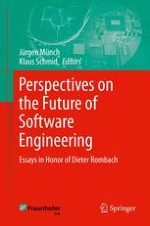
2013 | OriginalPaper | Buchkapitel
Empirical Software Engineering Models: Can They Become the Equivalent of Physical Laws in Traditional Engineering?
verfasst von : Dieter Rombach
Erschienen in: Perspectives on the Future of Software Engineering
Verlag: Springer Berlin Heidelberg
Aktivieren Sie unsere intelligente Suche, um passende Fachinhalte oder Patente zu finden.
Wählen Sie Textabschnitte aus um mit Künstlicher Intelligenz passenden Patente zu finden. powered by
Markieren Sie Textabschnitte, um KI-gestützt weitere passende Inhalte zu finden. powered by